The Eureka Police Department held a pair of events at the Humboldt County Office of Education’s still shiny Sequoia Conference Center Thursday. The aim? To provide the public with tips on how they can reduce their chances of ending up the victim of a gun-toting lunatic. Judging by attendance, this is highly prized information — LoCO had to park down the street as around 150 citizens packed the place.
EPD Captain Brian Stephens presided over the training, offering active shooter-thwarting suggestions, statistics and demonstrations.
“The Eureka Police Department is here today because we care about our community,” Stephens said. “I care about you guys … and if one person in here — and God forbid it ever happens — finds themselves in an active-shooter situation and anything you’ve learned here today helps you save a life, then I’ve accomplished my mission for the day.”
While there has never been such an incident in Eureka, mass shootings are on the rise nationally. According to stats provided by EPD at Thursday’s event, there were 323 mass shootings in the U.S. in 2015. There have already been 36 in 2016. A “mass shooting,” here, is defined as an incident in which “four or more persons [are] shot and or killed in a single event at generally the same time and location, not including the shooter.” (While websites that routinely track such events have slightly different tallies, a count of 323 resides in the same ballpark with the rest of the crowd.)
Terminology note: While active-shooter incidents can be classified as mass shootings, not all mass shootings are caused by an active shooter. Gang violence, for example, would not qualify as active-shooter incidents. With that in mind, here are some more stats provided by EPD, courtesy of the FBI:
- 160 active shooter incidents occurred between 2000-2013
- Approximately 60% of the shootings ended before police arrived
- 40% of the incidents ended with the shooter committing suicide
- In 13% of the shootings, the incidents ended after unarmed citizens safely and successfully restrained the shooter
- In 28% of the incidents, law enforcement had to engage the shooter to end the threat. In almost half of these incidents law enforcement suffered casualties.
- In five incidents the shooting ended after armed individuals (non-law enforcement) exchanged gunfire with the shooter
- Where it could be ascertained, 69% of the incidents ended in less than five minutes with 23% ending in two minutes
EPD dispatcher Katie Kime explains the mindset of those in her position during emergencies.
There was a ton of what you might classify as common sense information provided during the training, more than LoCO will reproduce here — the entire event was filmed for later airing on Access Humboldt should you want to catch up — but just to give you the flavor of the tips, here is a brief rundown of one easily rememberable action plan. Listen up! Should you ever find yourself in an active-shooter situation here is the mental triage order of operations for how you should react: Run —> Hide —> Fight. Let us elaborate:
RUN:
- If there is an escape path, attempt to evacuate.
- Evacuate whether others agree to or not.
- Leave your belongings behind.
- Help others escape if possible.
- Prevent others from entering the area.
- Call 911 when you are safe.
If you can’t run, then…
HIDE:
- Your hiding place should be out of the shooter’s view,
- provide protection if shots are fired in your direction, and
- not trap or restrict your options for movement.
If you can’t hide, then…
FIGHT:
- Attempt to incapacitate the shooter.
- Act with physical aggression.
- Improvise weapons.
- Commit to your actions.
Training attendees watch a video providing tips on how to survive an active shooter.
This threefold concept was further explored in a “Run! Hide! Fight!” video produced jointly by the City of Houston and Homeland Security and screened at the event. You can watch it below. As you might expect due to the subject matter, the video would seem graphic if, say, you saw it on TV (but probably not so much on the Internet):
A second (longer, more graphic) clip with more tips was also screened for attendees, this one courtesy the Los Angeles Sheriff’s Department:
Dale Loyd attended the training with his wife Tina and “thought it was really good.” The older couple also recently attended a concealed-weapons course as they want to be “as prepared as possible” for any dangerous situation that could arise.
“I think people need to be more aware that this could happen here,” Tina said. While she does not characterize herself as a fearful person, Tina said she’s been more aware of her surroundings lately. She regularly exercises at Planet Fitness and said she has a regular routine she executes when exiting her car and walking into the gym.
“I look all around me and I have my keys in my hand,” Tina said. “As soon as I get out of my car, I lock it and head straight in.”
The pair said they had been discussing what improvised weapon to use in the event they were ever under attack. Dale said he’d use his belt buckle. When we asked Tina how she would disable her attacker she took a playful swing at us with her purse.
“How about that?” she said, laughing.
A slide featuring everyday items one might use to incapacitate an attacker.
Above and below: During the event, Stephens asked for a volunteer to jump rope, a task this young woman energetically performed. Then she was asked to jump rope again, only this time other attendees hucked rolls of toilet paper at her. Her ability to jump rope was, uh, diminished. This was an attempt to demonstrate how distracting/attacking an active shooter may inhibit their ability to kill you.
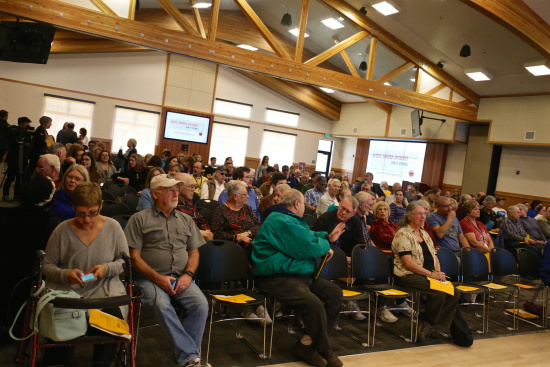
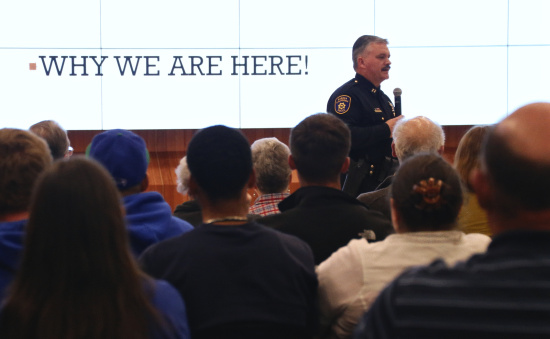
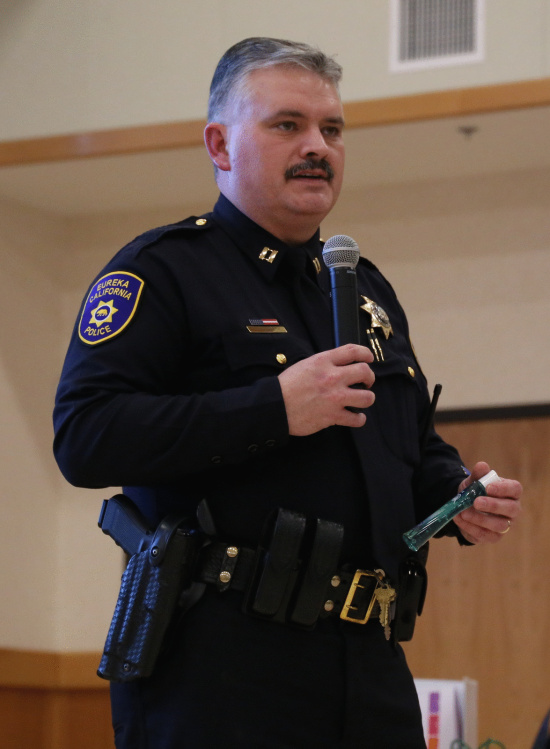
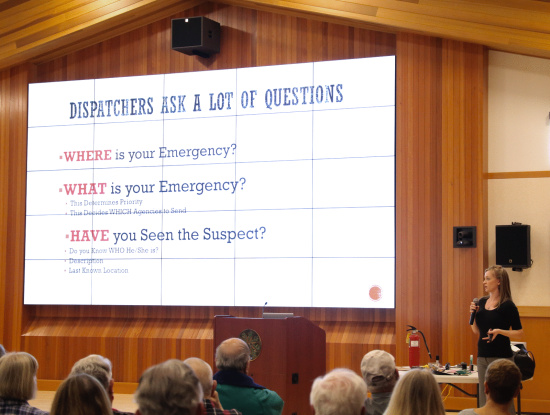

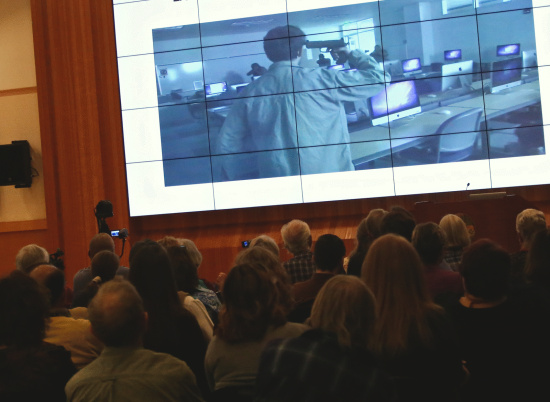
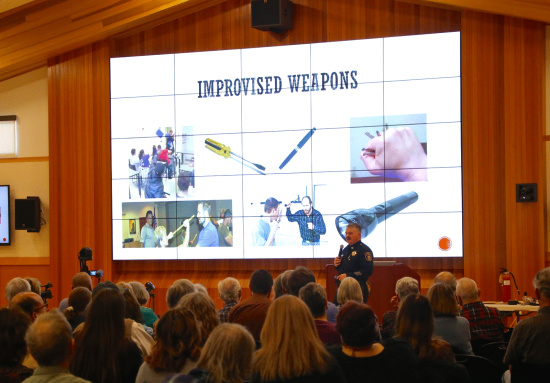
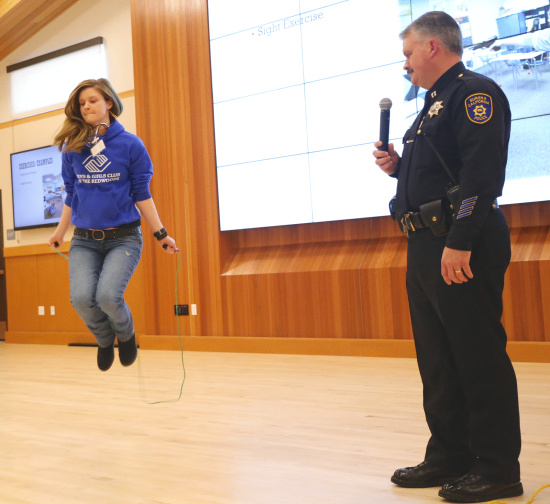
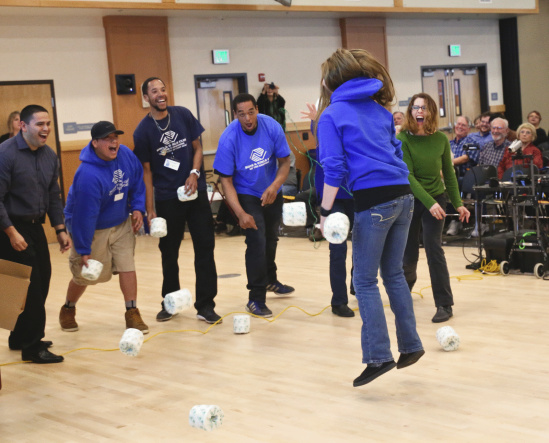
CLICK TO MANAGE